Ambitious geoscience program continues offshore Eastern Canada
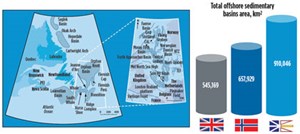
Noting that the frontier basins of Newfoundland and Labrador have been underexplored, officials at provincial company Nalcor Energy have been conducting a deliberate, thorough exploration campaign throughout the province’s offshore territory during the last five years. Their goal has been to invest in new geoscientific data to unlock the next areas of offshore Newfoundland and Labrador (NL) that may contain material prospectivity, ultimately delivering new resources for the benefit of the province’s people.
Bolstering the thesis that NL’s offshore basins have been underexplored are data comparisons of the province’s achievements, to date, with those of the UK and Norway. Keep in mind that NL’s total offshore sedimentary basins area is 910,046 km2, or nearly twice as much as that of the UK (545,169 km2) and 38% more than Norway’s area (657,929 km2), Fig. 1. Thus, looking at the three areas’ total exploration histories, the UK has drilled 2,861 exploratory wells (as of late 2015) for a ratio of 1 well per 191 km2. In Norway, 1,193 exploratory wells have been drilled, equal to a ratio of 1 well per 551 km2. Yet, in NL, only 161 wells have been drilled, equivalent to just 1 well per 5,652 km2, Fig. 2.
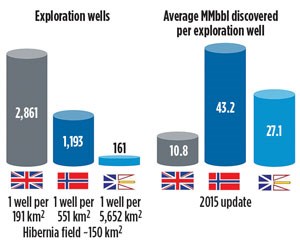
Nevertheless, the average amount of resources discovered, per well, in NL is about two-and-a-half times that of the UK, and close to being on a level with Norway, Fig. 2. In the UK, each exploration well finds an average 10.8 MMbbl of oil, while its counterpart in Norway discovers 43.2 MMbbl of oil. In NL, the average per exploration well is 27.1 MMbbl of oil.
NL’s large offshore totals are approximately 1.5 million km2. This province’s offshore area, stretching from the tip of Labrador to the south side of Newfoundland, is roughly equivalent to one-and-a-half times the size of the U.S. Gulf of Mexico OCS, Fig. 3. In this second installment of a multi-part article series on Eastern Canada, we examine the provincial government’s comprehensive program to identify and develop additional oil and gas resources over this vast territory.
A DELIBERATE NL STRATEGY
Nalcor Energy has taken a systematic, scientific approach to evaluating NL’s frontier basins. Through its proprietary Nalcor Exploration Strategy System (NESS), the provincial firm consistently evaluates all of NL’s basins (now more than 20) on the key elements that make up a commercial grade petroleum deposit. This process identifies critical knowledge gaps that may exist and highlights key risks holding back industry investment. Over the last five years, this process has resulted in several programs and studies, including the Airbus Satellite Seeps Project, the Metocean Study, and one of the world’s largest, multi-year seismic survey efforts, ever.
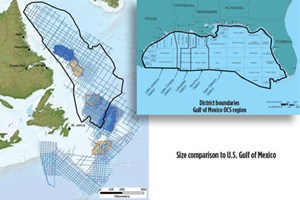
“We knew that we had to do something, when we realized that over 70% of the seismic data acquired up until 2010 was from the 1980s or earlier,” said Dr. Richard Wright, exploration manager at Nalcor. “Due to technological advancements in acquisition and processing, seismic imaging has been materially enhanced over the past three decades. We realized that we would need regional, high quality modern seismic if we were going to properly analyze NL’s frontier resource potential. One of our goals has been to close the seismic gap.”
Airbus Satellite Seeps Project. Back in 2010, in preparation for targeting a large scale regional 2D seismic program, Nalcor partnered with Airbus to conduct a satellite oil slick mapping project covering all of offshore NL. The data acquired during this survey has imaged areas of potential natural seepage in various basins and highlighted potential new regions for oil exploration. The project found a number of oil slicks that might indicate potential exploration targets and discoveries. “Indeed, the satellite found an oil slick that pointed to a prospect in Statoil’s Flemish Pass area, which, upon drilling, eventually proved to be a discovery well,” noted Wright. “This is nice proof of the satellite-based oil slick detection system pointing to hydrocarbon migration.”
Nalcor is continuing its partnership with Airbus. The partners have been focusing their efforts on areas covered in the 2016 and 2017 license rounds
Metocean study. In June 2015, Nalcor released the results of a Metocean study that it had undertaken with C-CORE, a Canadian research center specializing in ocean sciences, including Meteorology and Oceanography.
The Metocean project was a comprehensive study of met ocean conditions, including winds, waves, currents, fog, vessel icing, pack ice, icebergs and ice islands, and the influence of environmental changes on such conditions. The study illustrates what is known about the existing met ocean conditions for offshore Newfoundland and Labrador, and how the region ranks compared to other globally comparable frontier oil and gas regions around the world.
The study covers the entire Labrador Sea and Northern Grand Banks, Flemish Pass and Flemish Cap areas. The study area is divided into 391 grid cells, with each cell covering an average area of 3,760 km2. Data summaries for metocean parameters are available for each cell, and for the region. “Each cell has a roughly 200-page report,” noted Wright.
To facilitate the use of this vast dataset, Nalcor has used its NESS system. This system was developed in 2013 to capture insights from data collected within the exploration team.
Massive 2D seismic effort. In one of the industry’s greatest seismic efforts in history, Nalcor has partnered and invested with TGS and PGS in the acquisition of more than 110,000 km of multi-client 2D seismic, from 2011 through 2015. During the first four years of this project, about 84,000 line km were shot.
In the 2015 seismic program, an additional 28,000 line km were acquired, using two vessels. The plan called for acquiring 2D data in the Southeast Grand Banks, Southern Labrador, Northeastern and Eastern regions of offshore NL. The survey continued to focus on areas in the offshore that show prospectivity, as well as areas in frontier regions that have no previous data in the slope and deep water. It also covered areas that are included in the scheduled licensing rounds. The program is expected to continue throughout 2016.
Recent 3D programs. In July 2014, Nalcor said that it reached an agreement with an exploration company to carry out oil surveys off the NL coast, in the Orphan basin. Nalcor’s agreement with Electromagnetic Geoservices ASA called for the vessel Boa Galatea to collect 3D electromagnetic survey data in the Flemish Pass area, where recent major oil discoveries had been made by Statoil.
Last year, Nalcor partnered and invested with TGS and PGS in the acquisition of 4,600 km2 of multi-client 3D seismic data over the newly defined Lower Tertiary play trend in the West Orphan basin—an area included in the upcoming 2016 Eastern Newfoundland license round.
Seabed coring geochemistry project. Also in 2015, Nalcor invested in a multi-client geochemistry program that includes three of the Canada-Newfoundland and Labrador Offshore Petroleum Board’s (C-NLOPB) areas of interest in the upcoming 2016, 2017 and 2019 licensing rounds offshore NL. The project, conducted by partners MG3 and AGI, centered on collecting samples related to naturally occurring hydrocarbon surficial slicks and subsurface migration pathways.
MG3, as project operator, carried out the dynamic positioning survey, provided the coring vessel and performed all field activities. AGI was responsible for carrying out the analysis and reporting for the project. Approximately 100 seafloor coring samples, 14 heat flow data points, multi-beam bathymetry transects and 36 surface samples were acquired over these regions. “We used the insights from our seismic and satellite seep data to help inform what areas in our offshore to carry out the seabed coring study,” said Nalcor Executive V.P. Jim Keating. “Through the seabed coring study, we have indications of areas where potential hydrocarbon release has occurred.” A second phase of the program was expected in 2016, pending approvals.
Bay du Nord. In June, Statoil finalized a 19-month exploration drilling program in the Flemish Pass basin. The nine-well campaign resulted in two oil discoveries, at the Bay de Verde and Baccalieu prospects, in the Bay du Nord area, both of which added to the resource base for a potential development at the Bay du Nord discovery. According to Statoil, the discovery holds between 300 and 600 MMbbl of recoverable oil.
NL LICENSING ROUNDS
To further the aim of increasing offshore exploration and encouraging greater operator participation, NL have implemented a new, Scheduled Land Tenure System. This system divides the offshore into eight regions and categorizes them, based on the level of historical exploration activity. Scheduled licensing rounds will be held in each region, on either a one-, two- or four-year cycle.
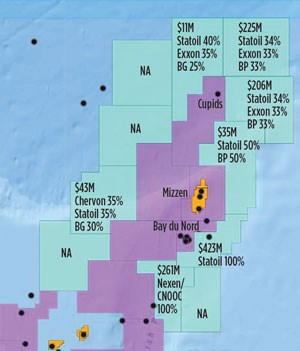
The tracts offered are based, in large part, on updated knowledge from the current seismic program. What follows are summaries of the 2015 round, conducted by the by the C-NLOPB, and what is expected in the 2016-2019 rounds.
The 2015 round. Situated 475 km east of St. John’s, the 2015 licensing round covered 11 parcels in the NL01-EN sector. The sector was positioned in the east-central portion of the Eastern Newfoundland Region and covered an area of 23,600 km2. Water depths range from 500 m on the slope to 3,300 m in the sector’s eastern-most deepwater area. Multiple vintages of seismic data exist over this area of the Flemish Pass basin, with more recent 2D acquisitions available as multi-client data. More than a dozen-and-a-half offset wells are near this sector.
“Nalcor in partnership with the Newfoundland and Labrador Department of Natural Resources on Oct. 1, 2015, released a resource assessment covering the 2015 round area that shows an in-place P50 resource potential of 12 Bbbl of oil and 113 Tcf of gas, in the 2015 licensing area offshore Newfoundland and Labrador,” said Wright. “That equates to 34.6 Bboe.”
The C-NLOPB released results for the 2015 License Round on Nov. 12, 2015, Fig. 4. In the results announced, seven winning bids were awarded, totaling $1.2 billion. Five of the seven licenses were awarded to Statoil. The other two went to Chevron and Nexen. In 2015, approximately 9% of the NL offshore was covered by either a license, a call for bids or a sector. However, by 2017, officials said that up to 20% of the offshore area could be covered by licenses, calls for bids and sectors.
The 2016 round. Located 430 km east-northeast of St. John’s, the 2016 License Round covers the NL02-EN sector (Fig. 5), which has been divided into nine defined parcels by the C-NLOPB. The sector lies in the northwestern portion of the Eastern Newfoundland Region and covers an area of 19,800 km2. Water depths range from 1,000 m on the slope to 3,000 m in the sector’s eastern-most deepwater area.
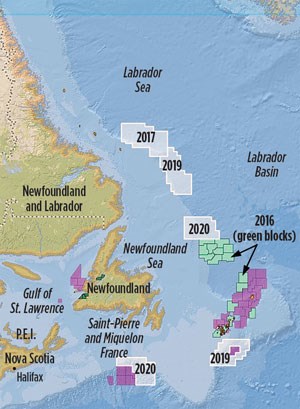
Multiple vintages of seismic data exist over this part of the Orphan basin, with more recent 2D and 3D acquisitions available as multi-client data. There are four offset wells near this sector. To date, no wells have been drilled directly in this sector. A publicly released resource assessment for the region is expected in the third quarter of this year. In addition to the nine defined parcels contained within the NL02-EN Sector, four open parcels from the 2015 round are also open to bidding.
The 2017 round. About 275 km east-northeast of Cartwright, the 2017 License Round will occur over the NL01-LS sector (Fig. 7), which will be divided into defined parcels by the C-NLOPB in early 2017. The sector lies in the central portion of the Labrador South Region and covers an area of 22,900 km2. Water depths range from 500 m on the slope to 3,000 m in the sector’s eastern-most deepwater area.
Multiple vintages of seismic data exist over this region, with more recent 2D acquisitions available as multi-client data. There are a dozen offset wells near this sector. To date, no wells have been drilled directly in this sector. A publically released resource assessment for the region is expected in the early third quarter of 2017.
The 2019 round/Labrador South region. Approximately 340 km2 east of Cartwright, this first of two 2019 licensing rounds will occur over the NL02-LS sector (Fig. 5), which will be divided into defined parcels by the C-NLOPB in early 2019. The sector lies in the south-central portion of the Labrador South Region and covers an area of 19,900 km2. Water depths range from 500 m on the slope to 3,000 m in the sector’s eastern-most deepwater region.
Multiple vintages of seismic data exist over this region, with more recent 2D acquisitions available as multi-client data. Two offset wells are near this sector. To date, no wells have been drilled directly in this sector. A publically released resource assessment for the region is expected in the early third quarter of 2019.
The 2019 round/Southeastern Newfoundland region. Roughly 430 km east-northeast of St. John’s, this second of two 2019 licensing rounds will occur over the NL01-SEN sector (Fig. 5), which will be divided into defined parcels by the C-NLOPB in early 2019. The sector lies in the north-central north portion of the South Eastern Newfoundland Region and covers an area of 21,600 km2. Water depths range from 1,100 m on the slope to 3,100 m in the sector’s eastern-most deepwater region.
Multiple vintages of seismic data exist over this region, with more recent 2D acquisitions available as multi-client data. There are four offset wells near this sector. In addition, four wells have been drilled directly in this sector. A publically released resource assessment for the region is expected in the early third quarter of 2019.
NOVA SCOTIA
Not all the Eastern Canadian geoscience effort has been conducted offshore NL. To the contrary, Nova Scotia (NS) has pushed forward its own agenda of activity. No less than the NS Department of Energy (DOE), the Offshore Energy Research Association, and the Canada-Nova Scotia Offshore Petroleum Board (CNSOPB) have instituted geoscience analysis programs to help reduce offshore geological risk, and support future Calls for Bids.
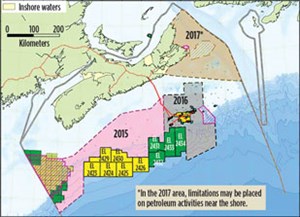
In 2009, the NS DOE commissioned a $15-million petroleum Play Fairway Analysis, examining previous drilling results and seismic research in the offshore. From this, the NS government is estimating the province’s offshore resource potential at more than 8 Bbbl of oil and 120 Tcf of gas.
And in June 2015, the NS DOE conducted a two-week research expedition in the Shelburne basin. The goal was to extract core samples from the ocean floor, about 2,600 m beneath the surface. “At least two of the core samples show good evidence of petrogenic hydrocarbons,” said Sandy MacMullin, executive director of the Petroleum Branch in the NS DOE. “This supports the suggestion that we happen to be in an area that’s oil-dominant as opposed to gas-dominant,” explained MacMullin.
The stepped-up geoscience efforts over the last ten years have attracted greater, renewed operator interest in the NS offshore. For instance, Shell Canada was awarded four deepwater parcels for a combined work expenditure of $970 million. And in 2012, BP was awarded four deepwater tracts for a total work commitment of $1.05 billion. Additionally, Shell Canada was awarded two deepwater and two shelf tracts for a commitment of $32 million. In total, the $2.05 billion committed represents the highest amount attained in Atlantic Canada, on both a per-bidding round and per-block basis.
Meanwhile, the CNSOPB issued a call for bids in April 2015, for the province’s 2015 licensing round, Fig. 6. Then, last Nov. 12, CNSOPB announced that its Call for Bids had resulted in two successful bids. Statoil’s Canadian subsidiary was the successful bidder for Parcels 1 and 2, with a total of $82 million in Work Expenditure Bids. No bids were received on Parcels 3 through 9.
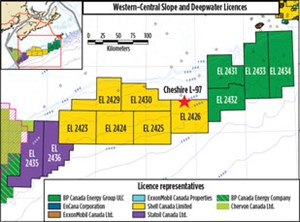
In addition, CNSOPB in May 2016 issued a Call for Bids for its 2016 licensing round, Fig. 6. There are six exploration parcels available for licenses, for which bids must be received by Oct. 27, 2016. Parcels 1, 2 and 3 are in shallow water on the Scotian Shelf, south of Sable Island, and are adjacent to current natural gas production from the Sable Offshore Energy Project. Parcels 4, 5 and 6 are south of Parcels 1, 2 and 3 on the outer shelf and slope of the central Scotian margin. Exploration wells drilled on parcels 1 and 4 have found significant quantities of natural gas. A comprehensive geoscientific assessment of these parcels shows that there is potential for significant hydrocarbon quantities on both the shelf and slope parcels.
Renewed exploratory drilling. Last October, Shell received CNSOPB approval to drill the first of two deepwater exploratory wells offshore NS, and drilling began shortly thereafter on the Cheshire L-97 wildcat, Fig. 7. In early 2016, Shell submitted an application to drill a second well, Monterey Jack. The Cheshire well was planned to reach a 7,532 m, MD, over an 11-to-12-month period. By March 5, workers on the Stena IceMAX drillship had drilled the well down to 6,700 m, MD, about 225 km southeast of Halifax.
However, that same day, as the Stena IceMAX crew was disconnecting the rig from the well, in preparation for bad weather approaching, high waves and heave caused the riser tensioner system to release, causing the riser and lower marine riser package to fall to the seabed. Shell and the CNSOPB suspended operations at the Cheshire wellsite, pending completion of an investigation into the incident.
Finally, on June 23, Shell said that it has been cleared by the CNSOPB to resume drilling the Cheshire well following an accident review.
According to CNSOPB, the key factors causing the incident were “the heave of the vessel and the inability of the riser tensioner system to compensate for the difference in the movement between the riser and the vessel with the tensioner system in a fully retracted position, and with the Riser Anti-Recoil System inactive.”
CNSOPB will require Shell Canada to lower its well disconnect criteria on the Stena IceMax, based on vessel heave of 5 m, until the board completes further reviews. The previous criterion was 8 m. ![]()
Editor’s note: Part 3 of this East Canada series will examine, in greater depth, the R&D efforts underway to help support greater E&P offshore NL and Nova Scotia.

- Advancing offshore decarbonization through electrification of FPSOs (March 2024)
- Subsea technology- Corrosion monitoring: From failure to success (February 2024)
- Prices and governmental policies combine to stymie Canadian upstream growth (February 2024)
- U.S. producing gas wells increase despite low prices (February 2024)
- U.S. drilling: More of the same expected (February 2024)
- U.S. oil and natural gas production hits record highs (February 2024)


